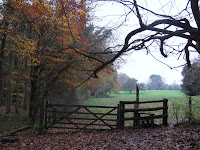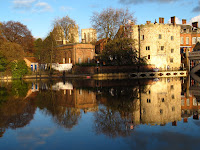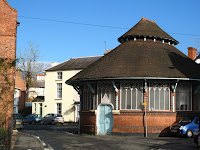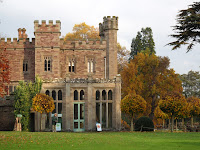The highlight of today was the excellent Titanic Exhibition at the O2. Rather than go directly there, we took the Tube to Surrey Docks, and enjoyed a walk along the south bank of the Thames, around the Greenland Dock area. Unlike the Chilterns walk yesterday, this part of London is full of closed pubs. We did find a little gem for lunch, and enjoyed an excellent value pub lunch at the Dog & Bell.
When we reached Greenwich, we decided to complete the last part of the Thames by boat, and this took us directly to the O2. This is a great place to sit in an “outdoors” cafe without actually being outside. The exhibition was fascinating. The range of artefacts recovered from the ocean floor is amazing, even non-durable items like playing cards and bank-notes have survived 88 years on the sea floor.
The entrance to the exhibition is with a 'boarding pass' in the name of one of the passengers. We were then able to check the passenger list to see if 'we' survived or not. Christine was a Second Class woman passenger who survived, but Murray was a Colonel travelling First Class who, very properly, went down with the ship.
Wednesday, November 24, 2010
Country Walking - 20 November 2010

Today was our last chance to take an autumn colours walk, before winter. The leaves were still hanging onto the beech trees in the Chilterns, and although cold, it was a surprisingly pleasant day for a walk.
 The walk from Cholesbury Common took us through seven villages, most with a pub, so no shortage of lunch venues. The high number of pubs closing does not appear to effect the Chilterns, as this is a well-heeled commuter belt west of London.
The walk from Cholesbury Common took us through seven villages, most with a pub, so no shortage of lunch venues. The high number of pubs closing does not appear to effect the Chilterns, as this is a well-heeled commuter belt west of London. The evening mist was forming in the valleys when we realised the instructions in our walk were not particularly clear. Fortunately the only walkers we had seen all day appeared as we were trying to decide which was the correct direction to head in. Amazingly we had met up with an expert walker who has published a book of walks in Southern England. He naturally was equipped with proper maps, and was able to point us in the right direction. We only just completed the walk before sunset.
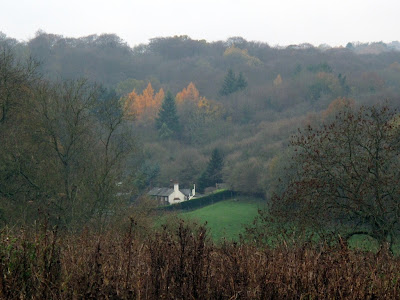
Tuesday, November 16, 2010
Steaming to York - 13 November 2010
After watching the 'Railway Children' this summer, with a real steam train on stage, we were inspired to take a steam train ride ourselves. For less than a first class return ticket to York on a modern train, we were able to take a steam train, seated at a table for two, enjoy a full English breakfast after departure, lunch before arrival in York, and a four course dinner during the return trip.
It sounded good value, but would it live up to our expectations? The original date was postponed, due to a fault with the steam engine, and we wondered if the postponement date in November would prove to be less pleasant weather-wise. But after 80mph winds on Thursday, Saturday was an almost perfect day, with sunshine along the entire trip. The start was early – 8am from Kings Cross, but the instant we pulled out of the station, we were served breakfast of a mixed melon starter, croissants and toast, followed by an excellent cooked breakfast. After sampling many different varieties for “Full English” during our time here from hotels and B&B's, this was as good as the best we've had.
The countryside rolled past in the wonderful winter sunshine, and after a light sandwich lunch, we pulled into York nearly five hours later. York is a wonderful city, and with four hours there, we had just enough time to fill in the gaps from a previous visit about six years ago.
A must in York is walking around the city walls. These encircle the city centre, with gate-houses at regular intervals. On a sunny day, this is really pleasant. The other must is the medieval York Minster. Completed in 1472 (after taking 250 years to build), this enormous cathedral, has Europe's largest stained glass window on it's eastern wall. We were most disappointed to find it covered up for restoration, but one positive side to this was there were two windows on display, so we could see close up the amazing mixtures of glass that goes into a window of this type. All manner of old pieces have been used (or replaced) in some panes, but the overall whole effect from ground level, is still harmonious.
The Shambles is a famous shopping street of old buildings. No sign of the recession in central York, and it was easy to see why these appealing streets of shops are so popular. Christmas decorations were out, and everything felt quite festive.
We still had time to visit Fairfax House. This is a Georgian townhouse, and it is the ability to step back in time, which made it appealing to visit. The dining table was set with a fantasy sweet concoction, which was fashionable in that era.
We retraced our way to the train station. This in itself is an interesting building; when completed in 1877 it was said to be the largest train station in Europe. Our train steamed in, and we left exactly on time.
After departing York, dinner was served. It was dark by this time, so easy to overlook the fact that we were beginning our dinner at 5.15pm. The courses came slowly, filling in several hours of the journey. The starter we choose was salmon and prawns, quite delicious, followed by fillet steak. As they hadn't asked how we liked our steak, we expected thin overdone steaks, after all they were catering for a large number of diners in a mobile kitchen. We were delighted to be proved wrong when thick tender pink steaks appeared, absolutely perfectly cooked, with great vegetable selection. Lemon desert and a cheese board followed. All in all a really memorable meal.
But during dinner, we noticed the train appeared to be getting slower. Eventually a manager appeared to inform us there was a problem. In York, they had the coal replenished, but had been given the wrong sort of coal. This made us laugh, as now we feel we've heard it all! In London we've been told the trains are late due to the wrong sort of leaves on the line, the wrong sort of rain, the wrong sort of snow, even the wrong sort of clouds and now the wrong sort of coal.
Eventually the train stopped altogether, and after a delay (I assume getting a head of steam), we limped into the next station. We were encouraged to take the regular service to London, from that station, our tickets would be honoured on the train. So we finally got back into Kings Cross about two hours late. It was an unfortunate ending to the day, but still a brilliant day out.
It sounded good value, but would it live up to our expectations? The original date was postponed, due to a fault with the steam engine, and we wondered if the postponement date in November would prove to be less pleasant weather-wise. But after 80mph winds on Thursday, Saturday was an almost perfect day, with sunshine along the entire trip. The start was early – 8am from Kings Cross, but the instant we pulled out of the station, we were served breakfast of a mixed melon starter, croissants and toast, followed by an excellent cooked breakfast. After sampling many different varieties for “Full English” during our time here from hotels and B&B's, this was as good as the best we've had.
The countryside rolled past in the wonderful winter sunshine, and after a light sandwich lunch, we pulled into York nearly five hours later. York is a wonderful city, and with four hours there, we had just enough time to fill in the gaps from a previous visit about six years ago.
A must in York is walking around the city walls. These encircle the city centre, with gate-houses at regular intervals. On a sunny day, this is really pleasant. The other must is the medieval York Minster. Completed in 1472 (after taking 250 years to build), this enormous cathedral, has Europe's largest stained glass window on it's eastern wall. We were most disappointed to find it covered up for restoration, but one positive side to this was there were two windows on display, so we could see close up the amazing mixtures of glass that goes into a window of this type. All manner of old pieces have been used (or replaced) in some panes, but the overall whole effect from ground level, is still harmonious.
The Shambles is a famous shopping street of old buildings. No sign of the recession in central York, and it was easy to see why these appealing streets of shops are so popular. Christmas decorations were out, and everything felt quite festive.
We still had time to visit Fairfax House. This is a Georgian townhouse, and it is the ability to step back in time, which made it appealing to visit. The dining table was set with a fantasy sweet concoction, which was fashionable in that era.
We retraced our way to the train station. This in itself is an interesting building; when completed in 1877 it was said to be the largest train station in Europe. Our train steamed in, and we left exactly on time.
After departing York, dinner was served. It was dark by this time, so easy to overlook the fact that we were beginning our dinner at 5.15pm. The courses came slowly, filling in several hours of the journey. The starter we choose was salmon and prawns, quite delicious, followed by fillet steak. As they hadn't asked how we liked our steak, we expected thin overdone steaks, after all they were catering for a large number of diners in a mobile kitchen. We were delighted to be proved wrong when thick tender pink steaks appeared, absolutely perfectly cooked, with great vegetable selection. Lemon desert and a cheese board followed. All in all a really memorable meal.
But during dinner, we noticed the train appeared to be getting slower. Eventually a manager appeared to inform us there was a problem. In York, they had the coal replenished, but had been given the wrong sort of coal. This made us laugh, as now we feel we've heard it all! In London we've been told the trains are late due to the wrong sort of leaves on the line, the wrong sort of rain, the wrong sort of snow, even the wrong sort of clouds and now the wrong sort of coal.
Eventually the train stopped altogether, and after a delay (I assume getting a head of steam), we limped into the next station. We were encouraged to take the regular service to London, from that station, our tickets would be honoured on the train. So we finally got back into Kings Cross about two hours late. It was an unfortunate ending to the day, but still a brilliant day out.
Thursday, November 11, 2010
Last look at autumn - 7th November 2010
Before leaving Hereford, we did the river walk again in the morning sun. We were out quite early, but not as early as the fishermen along the bank
The next city north of Hereford, is Leominster and from here we did a circular tour taking in Tenbury Wells and Ludlow before stopping at Croft Castle.
The original castle on this site was commissioned by William the Conqueror, as part of a string of castles protecting the Welsh border. Before looking around the present castle, which dates back to the 17th century, we joined a history talk about the castle. This was interesting, as the original owner was Croft but it passed out of the family's hands when a future owner lost his fortune in the South Sea investment bubble. But after 180 years, the Crofts finally bought the castle back after World War I.
From Croft Castle, we travelled south to Hampton Court. This is a stunning castle, totally restored by the American owners who purchased it in 1994. They developed a series of walled gardens, with water features and a tricky maze. The castle was surrounded by wonderful autumn trees – quite stunning.
Wye Not? - 6th November 2010
We had a weekend planned in Hereford, to catch the last of the autumn colours, so when 25mph winds ripped through the UK on Thursday, we wondered if there would be any leaves left on the trees. But when we reached our autumn feature for the day, The Forest of Dean, we were delighted to find the trees looking superb, with their rich golds, reds and bronzes.
We took the scenic route through the forest, with a stop for a walk at Symonds Yat Rock. This is a massive rock outcrop about the River Wye, overlooking the forests below, the town of Symonds Yat and the river curving in a horse-shoe. The trees were a wonderful autumn blaze of colour.
Our route took us past Goodrich Castle, ruined by Cromwell's troops, and on to Ross-on-Wye for lunch. This is a picturesque market town, with a covered market, the main street marching down the hill, and a soaring church steeple. Outside the church is a cross erected to commemorate the fact that in 1637 a total of 315 plaque victims were buried without coffins during the night. Next door to the church is a walled garden, overlooking the river, far below.
After lunch, we carried on to Hereford, parked at our city centre hotel and walked off to enjoy the town centre with its old buildings. The Tudor 'Old House' is a free museum, which gives a feel for how these old buildings were to live in.
The cathedral is magnificent, we have previously visited the Mappa Mundi and Chained Library here, definitely worth a visit.
The city is also built on the banks of the Rive Wye and, here too, we enjoyed the autumn colours as we walked along the riverside path before returning to our hotel.
We took the scenic route through the forest, with a stop for a walk at Symonds Yat Rock. This is a massive rock outcrop about the River Wye, overlooking the forests below, the town of Symonds Yat and the river curving in a horse-shoe. The trees were a wonderful autumn blaze of colour.
Our route took us past Goodrich Castle, ruined by Cromwell's troops, and on to Ross-on-Wye for lunch. This is a picturesque market town, with a covered market, the main street marching down the hill, and a soaring church steeple. Outside the church is a cross erected to commemorate the fact that in 1637 a total of 315 plaque victims were buried without coffins during the night. Next door to the church is a walled garden, overlooking the river, far below.
After lunch, we carried on to Hereford, parked at our city centre hotel and walked off to enjoy the town centre with its old buildings. The Tudor 'Old House' is a free museum, which gives a feel for how these old buildings were to live in.
The cathedral is magnificent, we have previously visited the Mappa Mundi and Chained Library here, definitely worth a visit.
The city is also built on the banks of the Rive Wye and, here too, we enjoyed the autumn colours as we walked along the riverside path before returning to our hotel.
Monday, November 01, 2010
No tricks, all treats – 30 October 2010
Autumn colours are almost like a drug; if the sun is shining, we have to get out for another 'fix'. The only place free of showers today was north of London, so we headed for Braintree, and enjoyed a circular drive taking in Sudbury and Nayland.
One hidden gem we discovered on the way to Sudbury, was Wissington. This hamlet has an 11th century church down a no exit, tiny road, is such a tranquil spot, it made us feel like a million miles from London. Inside the church are 13th century wall paintings, the one which really appealed was a very stylish dragon (no sign of St George though).
appealed was a very stylish dragon (no sign of St George though).
Sudbury is the home town of Thomas Gainsborough, the famous 18th century painter. We visited the house where he was born and grew up. It has now been turned into an art gallery, displaying, predominately, Gainsborough's paintings.
After passing through several picturesque villages, all painted in pastel colours, we arrived in Stratford St Mary. We had a five mile walk starting at the tudor Le Talbooth restaurant, once featured in a painting by Constable. It is still a fabulous spot, although spoilt by the busy roads nearby. Before the walk, we had a superb lunch at Milsoms, the sister restaurant around the corner.
The circular walk took in parts of the Essex Way, and returned by the Stour Walkway. There was still time in the day to complete our drive through Earls Colne to Halstead. The most interesting part of Halstead is beside the River Colne, where the old silk mills are now used as an antiques centre.


For the eve of Halloween, we were delighted to have been treated to excellent weather, as half way home we ran onto very wet roads, obviously the forecast was right, convincing us to go far enough north to be out of reach of the passing showers
One hidden gem we discovered on the way to Sudbury, was Wissington. This hamlet has an 11th century church down a no exit, tiny road, is such a tranquil spot, it made us feel like a million miles from London. Inside the church are 13th century wall paintings, the one which really
 appealed was a very stylish dragon (no sign of St George though).
appealed was a very stylish dragon (no sign of St George though).Sudbury is the home town of Thomas Gainsborough, the famous 18th century painter. We visited the house where he was born and grew up. It has now been turned into an art gallery, displaying, predominately, Gainsborough's paintings.
After passing through several picturesque villages, all painted in pastel colours, we arrived in Stratford St Mary. We had a five mile walk starting at the tudor Le Talbooth restaurant, once featured in a painting by Constable. It is still a fabulous spot, although spoilt by the busy roads nearby. Before the walk, we had a superb lunch at Milsoms, the sister restaurant around the corner.
The circular walk took in parts of the Essex Way, and returned by the Stour Walkway. There was still time in the day to complete our drive through Earls Colne to Halstead. The most interesting part of Halstead is beside the River Colne, where the old silk mills are now used as an antiques centre.


For the eve of Halloween, we were delighted to have been treated to excellent weather, as half way home we ran onto very wet roads, obviously the forecast was right, convincing us to go far enough north to be out of reach of the passing showers
Subscribe to:
Posts (Atom)










